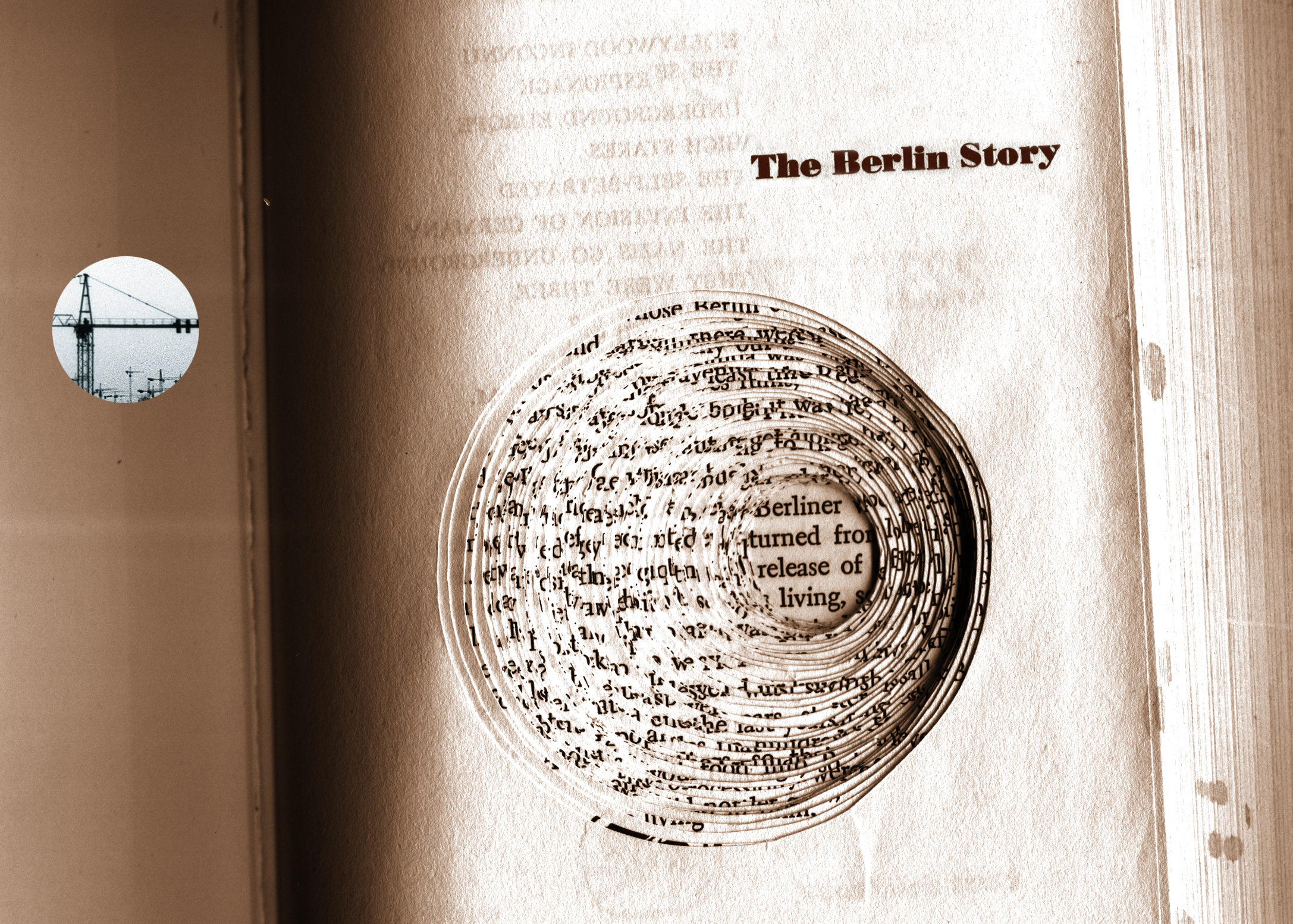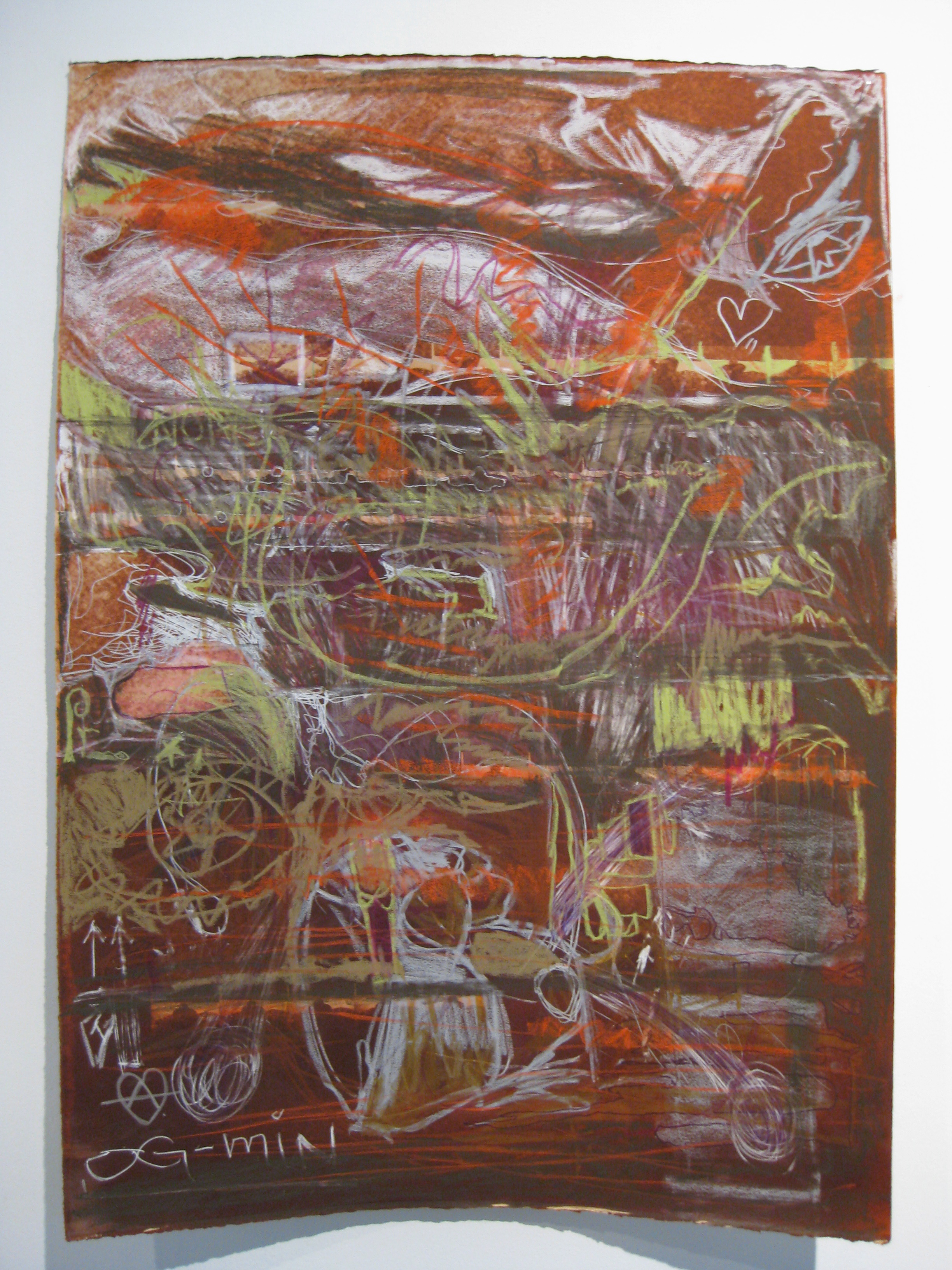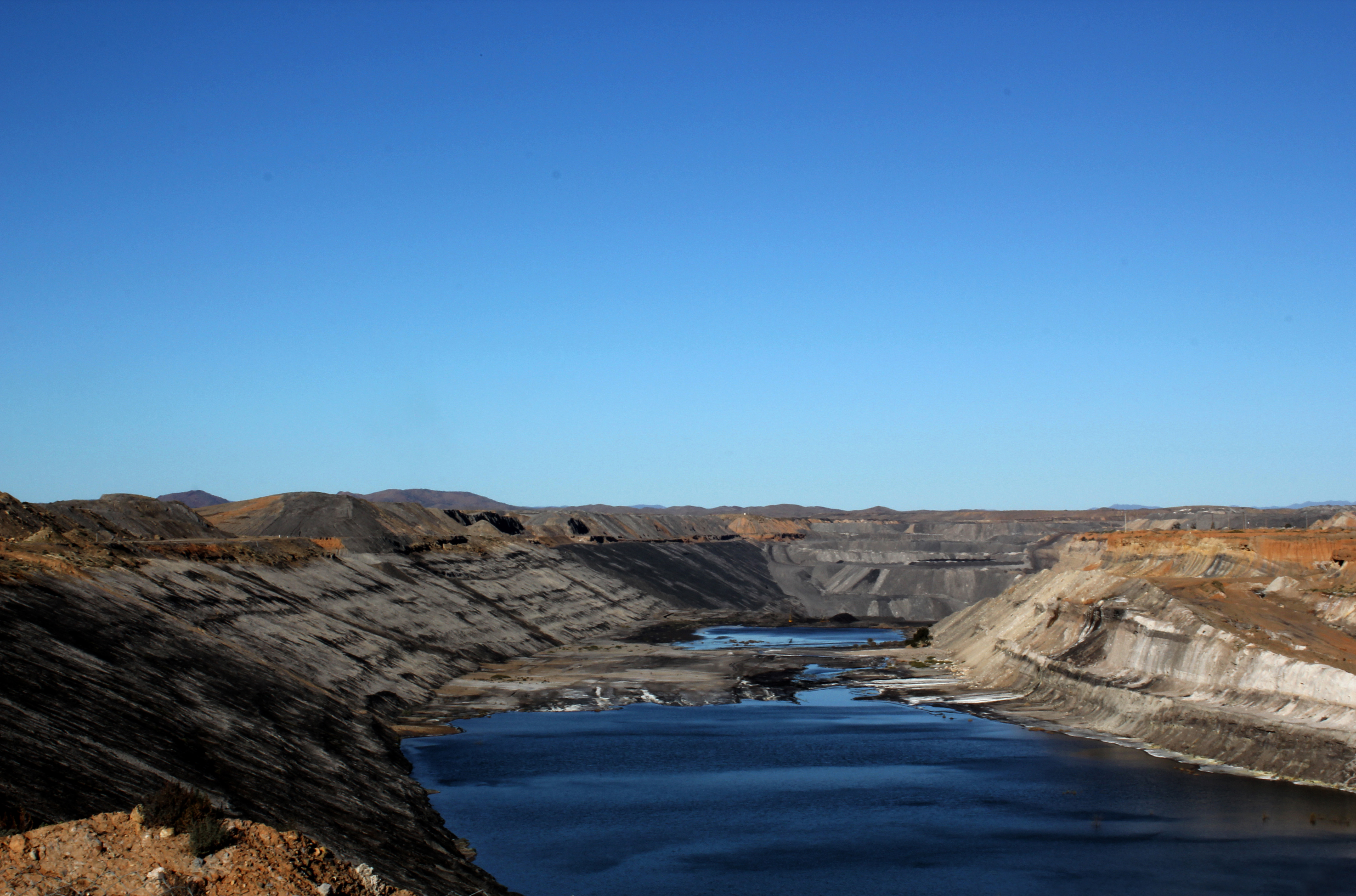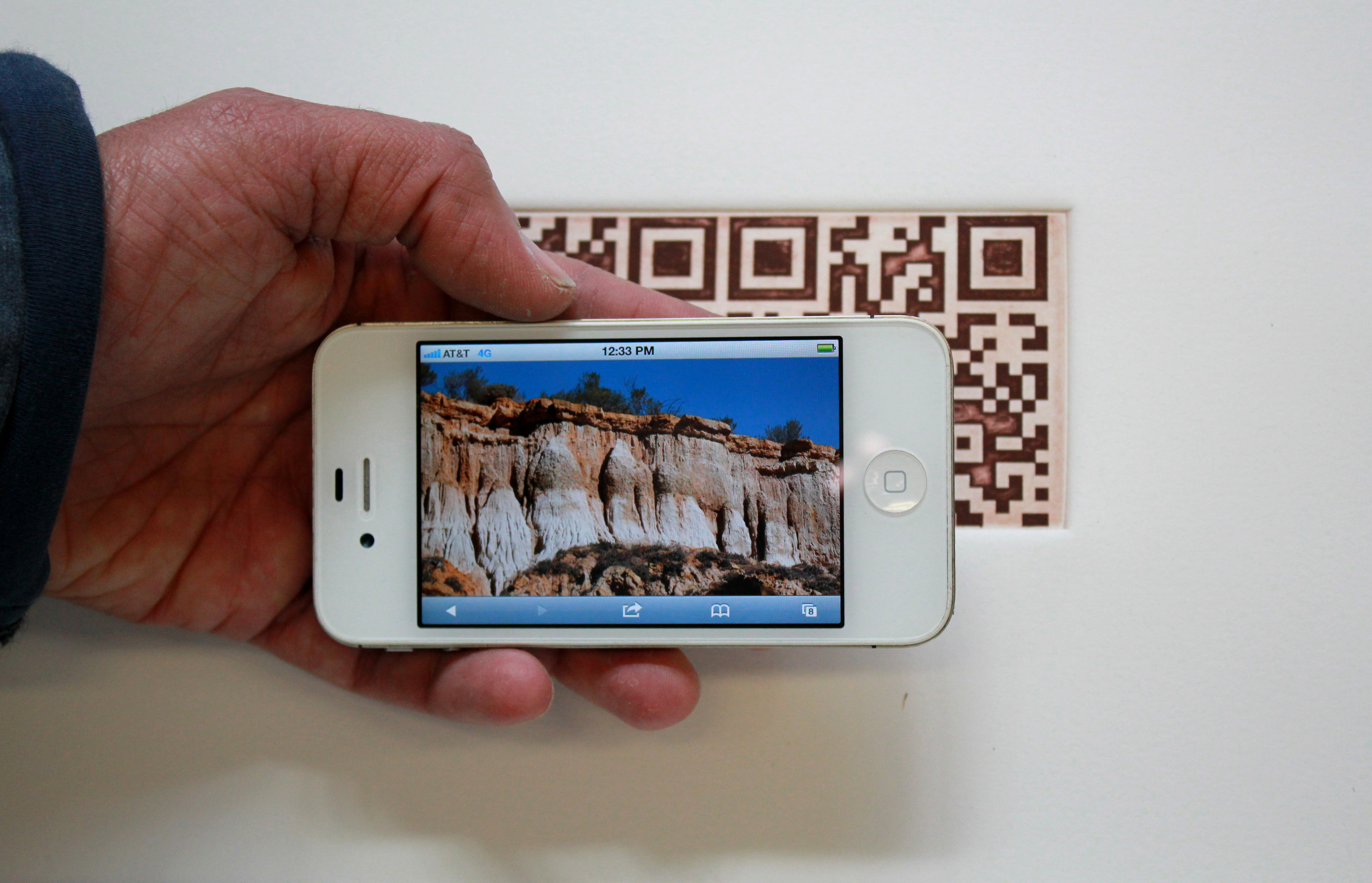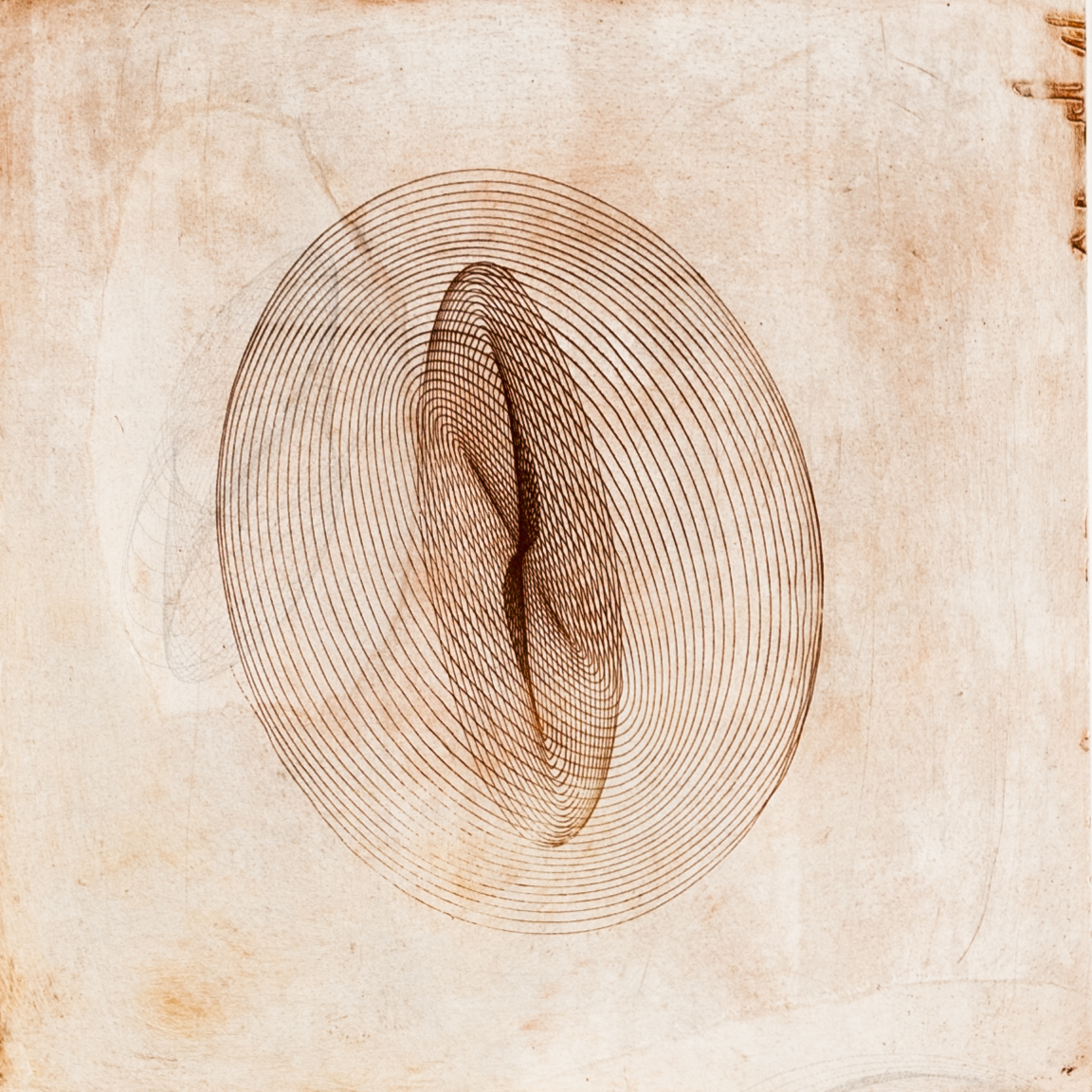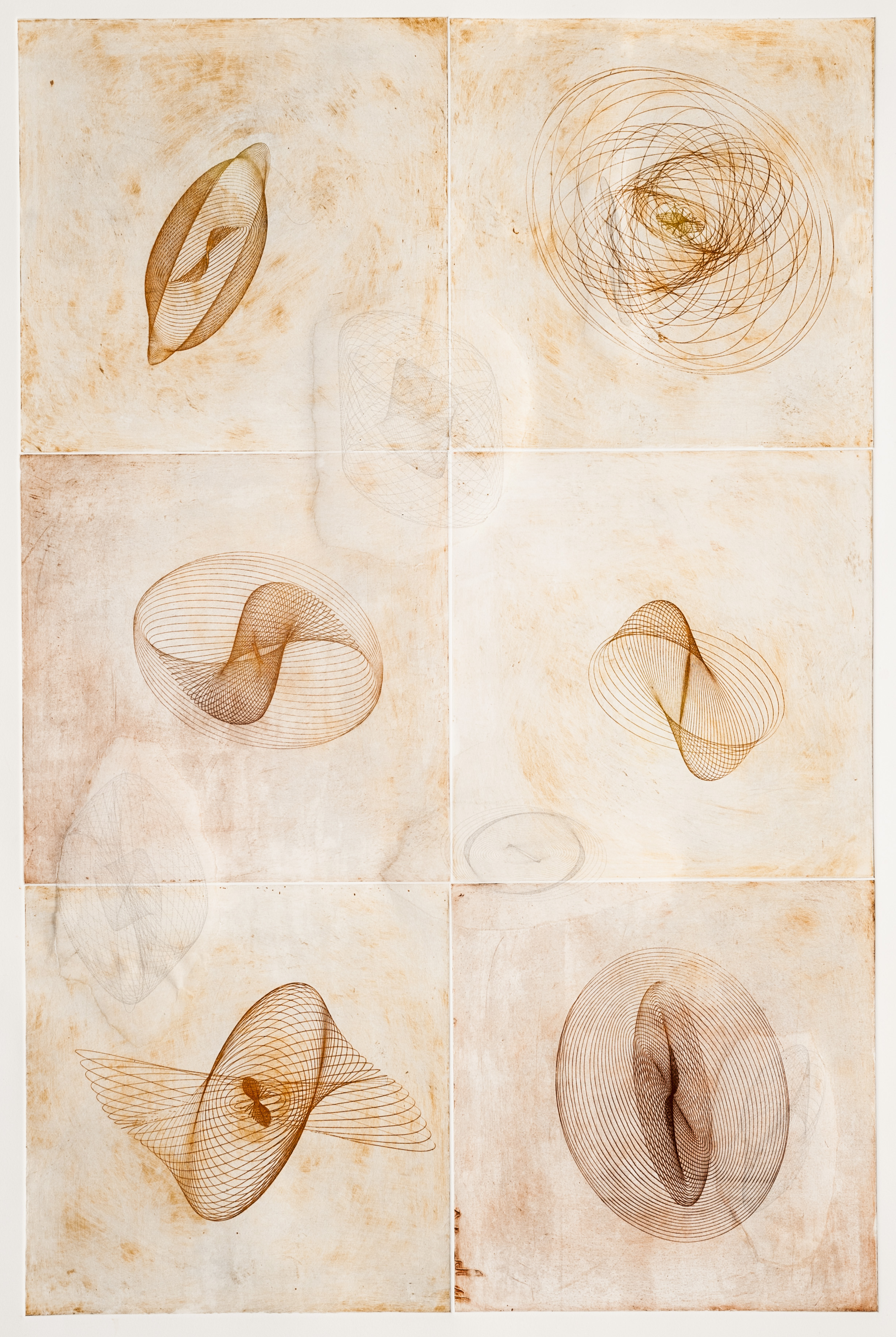About Lisa

Lisa Moren is an artist who has been making interactive installations, works on paper and public interventions for over 20 years. Recently she has been making pigments from polluted water and other landscapes with a compelling narrative. She has exhibited her work widely including the Chelsea Art Museum, Eyebeam, Cranbrook Art Museum and many venues abroad such as Ars Electronica and Akademie der Kunste and is currently working with the Artists Research Network, part of LaTrobe University in… more
Jump to a project:
Early Electronic and Media Projects
These projects show early experiments in hybrid forms of emerging media with materials.
Last Hour of Analog TV, 2009
la_alma, 1999
Lemons Making Their Own Lemon Meringue Pie, 2007
CLEAN, 2007
dedos, Interactive Hand Creme, 2001
Bride, stripped bare, 2001
a conversation, Hansel + Gretel, 1994
Last Hour of Analog TV, 2009
la_alma, 1999
Lemons Making Their Own Lemon Meringue Pie, 2007
CLEAN, 2007
dedos, Interactive Hand Creme, 2001
Bride, stripped bare, 2001
a conversation, Hansel + Gretel, 1994
-
a conversation, Hansel + Gretel, 1994CD ROM (re-editioned1999). This video clip documents a walkthrough of what a participant may experience clicking through this screen based project. Two performers, tell the story of Hansel & Gretel (Louis Hock & Carol Hobson) while speaking in the first person. Their narratives are interwoven with romantic images of women just prior to experiencing violence in Hollywood films. Likewise, when the viewer selects "him" or "her" version of the narrative, they briefly see feedback flashing a similar cartoon image. See Video.
-
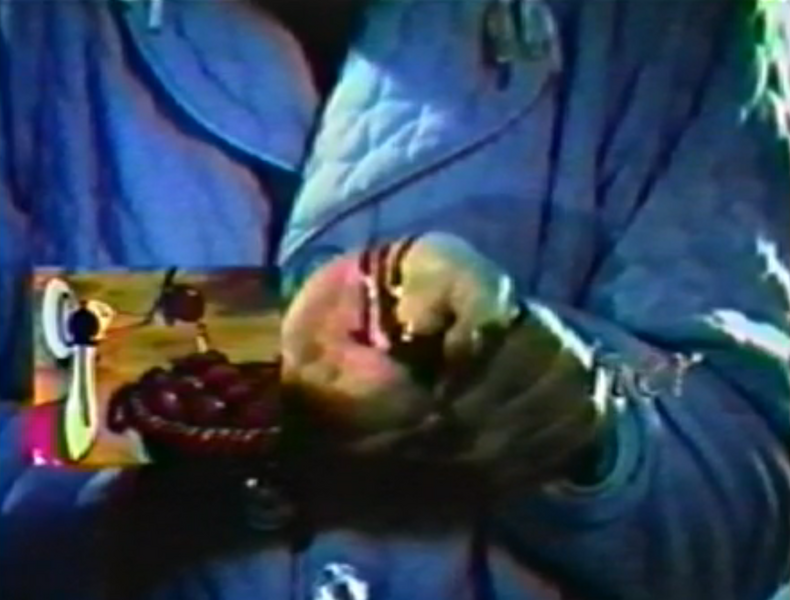 a conversation, Hansel + Gretel, 1994CD ROM (still) Two performers, tell the story of Hansel & Gretel (Louis Hock & Carol Hobson) while speaking in the first person. Their narratives are interwoven with romantic images of women just prior to experiencing violence in Hollywood films. Likewise, when the viewer selects "him" or "her" version of the narrative, they briefly see feedback flashing a similar cartoon image. See Video.
a conversation, Hansel + Gretel, 1994CD ROM (still) Two performers, tell the story of Hansel & Gretel (Louis Hock & Carol Hobson) while speaking in the first person. Their narratives are interwoven with romantic images of women just prior to experiencing violence in Hollywood films. Likewise, when the viewer selects "him" or "her" version of the narrative, they briefly see feedback flashing a similar cartoon image. See Video. -
Bare, stripped bride, 2001Video 4:45min This short video reveals a true narrative of a woman who the year she was married, requests her childhood home movies from her mother but instead is given 8mm soft porn film reels entitled "Nautical Nudest Weekend, Part I". No edits were made by the artist, the cartoon imagery is original. Instead the artist used a variety of technologies to make the antiquated film visible. The audio was likewise produced in the same way. Voiceover by Karla Peterson
-
 Bare, stripped bride, 2001Video 4:45min. The year the narrator was married requests her childhood home movies from her mother. However, her mother erroneously sends her 8mm films that include soft porn film reels such as this one "Nautical Nudest Weekend, Part I". In this video, no edits were made by the artist, the cartoon imagery cutting to the boat image is original (meant to bypass the censors). Instead the artist used a variety of technologies to make the antiquated film visible. The audio was likewise produced in the same way. Voiceover by Karla Peterson. See Video.
Bare, stripped bride, 2001Video 4:45min. The year the narrator was married requests her childhood home movies from her mother. However, her mother erroneously sends her 8mm films that include soft porn film reels such as this one "Nautical Nudest Weekend, Part I". In this video, no edits were made by the artist, the cartoon imagery cutting to the boat image is original (meant to bypass the censors). Instead the artist used a variety of technologies to make the antiquated film visible. The audio was likewise produced in the same way. Voiceover by Karla Peterson. See Video. -
Lemons Making Their Own Lemon Meringue Pie, 2006Video 4:34min. This domestic-mechanico video documents the technique of lemon batteries working hacked kitchen gadgets with a pseudo-goal to make lemon meringue pie.
-
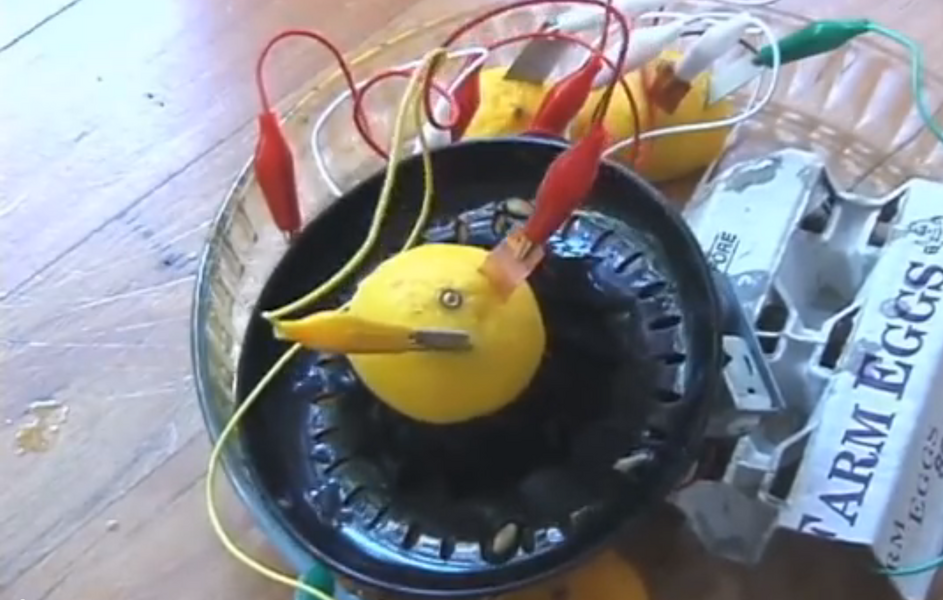 Lemons Making Their Own Lemon Meringue Pie, 2006-2007Video 4:34 min. This domestic-mechanico video documents the technique of lemon batteries working hacked kitchen gadgets with a pseudo-goal to make lemon meringue pie. See Video.
Lemons Making Their Own Lemon Meringue Pie, 2006-2007Video 4:34 min. This domestic-mechanico video documents the technique of lemon batteries working hacked kitchen gadgets with a pseudo-goal to make lemon meringue pie. See Video. -
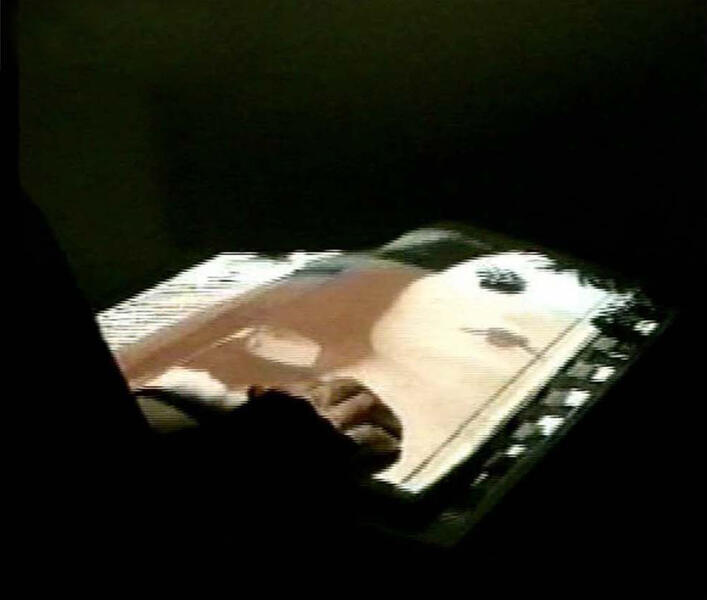 la_alma, 1999-2001Interactive video installation (Open book 17x 25”) Hand made vellum book, hacked keyboard, handmade sensors, archive of 80 original videos, Imag/ine software and looping audio CD. The viewer is invited to touch the blank pages of an open book. If the viewer touches the book montage imagery of ticking machines, microfische, obsolete handwritting, and the palimpsestual nature of former East Berlin reveal a lost time in the life of a woman who has nearly forgotten language. See Video.
la_alma, 1999-2001Interactive video installation (Open book 17x 25”) Hand made vellum book, hacked keyboard, handmade sensors, archive of 80 original videos, Imag/ine software and looping audio CD. The viewer is invited to touch the blank pages of an open book. If the viewer touches the book montage imagery of ticking machines, microfische, obsolete handwritting, and the palimpsestual nature of former East Berlin reveal a lost time in the life of a woman who has nearly forgotten language. See Video. -
 la_alma, 1999.Interactive video installation (Open book 17x 25”) Hand made vellum book, hacked keyboard, handmade sensors, archive of 80 original videos, Imag/ine software and looping audio CD. The viewer is invited to touch the blank pages of an open book. If the viewer touches the book montage imagery of ticking machines, microfische, obsolete handwritting, and the palimpsestual nature of former East Berlin reveal a lost time in the life of a woman who has nearly forgotten language. See Video.
la_alma, 1999.Interactive video installation (Open book 17x 25”) Hand made vellum book, hacked keyboard, handmade sensors, archive of 80 original videos, Imag/ine software and looping audio CD. The viewer is invited to touch the blank pages of an open book. If the viewer touches the book montage imagery of ticking machines, microfische, obsolete handwritting, and the palimpsestual nature of former East Berlin reveal a lost time in the life of a woman who has nearly forgotten language. See Video. -
la_alma, 1999-2001Interactive video installation (Open book 17x 25”) Hand made vellum book, hacked keyboard, handmade sensors, archive of 80 original videos, Imag/ine software and looping audio CD. The viewer is invited to touch the blank pages of an open book. If the viewer touches the book montage imagery of ticking machines, microfische, obsolete handwritting, and the palimpsestual nature of former East Berlin reveal a lost time in the life of a woman who has nearly forgotten language. This video documents one possible interaction of thousands from over 150 archived videos. 8:33min.
-
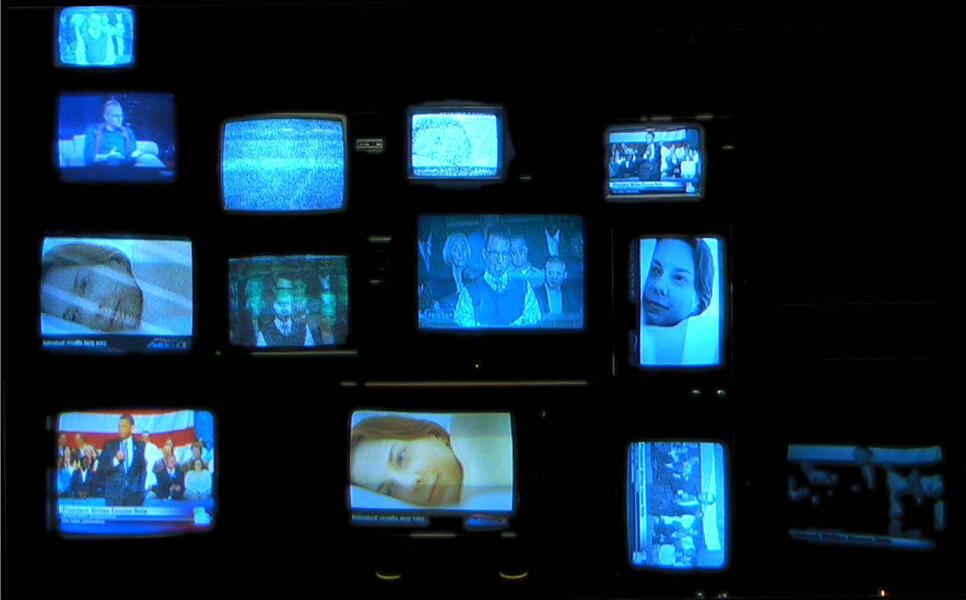 Last Hour of Analog TV, 200916x9' installation, 13 analog televisions A video and installation that documents the last hour of analog tv, including the moment on June 15, 2009 when US national television converted to a digital signal, and broadcast imagery turned to snow. Project was later projected onto 300lb block of ice (not shown). For a 10min. excerpt documenting the transition see: http://youtu.be/h1UJ1LOGnTI
Last Hour of Analog TV, 200916x9' installation, 13 analog televisions A video and installation that documents the last hour of analog tv, including the moment on June 15, 2009 when US national television converted to a digital signal, and broadcast imagery turned to snow. Project was later projected onto 300lb block of ice (not shown). For a 10min. excerpt documenting the transition see: http://youtu.be/h1UJ1LOGnTI
Récord, Recórd, recollection II
Like the magnetic head of a tape recorder reading a cassette tape, viewers are invited to draw audio in order to hear citizens of Prague remembering their former Communist past. Sensors are hidden behind vandyke prints that eventually fade, archiving the listeners. The project features Czech artists who were imprisoned or in exile such as Fluxus artist Milan Knizak and Milos Voytechovsky.
Interactive Audio Installation, dimensions variable. Unfixed vandyke prints on rag paper; 40 7x7" force sensing resistors (trackpad-like sensors); speakers, analog to digital converters; apple laptop; Isadora and OSC software. Software programmed by Mark Coniglio with voltage to digital converter by Sukandar Kartadinata designed in collaboration with the artist. Special thanks to J. William Fulbright and CEC Artslink International.
Interactive Audio Installation, dimensions variable. Unfixed vandyke prints on rag paper; 40 7x7" force sensing resistors (trackpad-like sensors); speakers, analog to digital converters; apple laptop; Isadora and OSC software. Software programmed by Mark Coniglio with voltage to digital converter by Sukandar Kartadinata designed in collaboration with the artist. Special thanks to J. William Fulbright and CEC Artslink International.
-
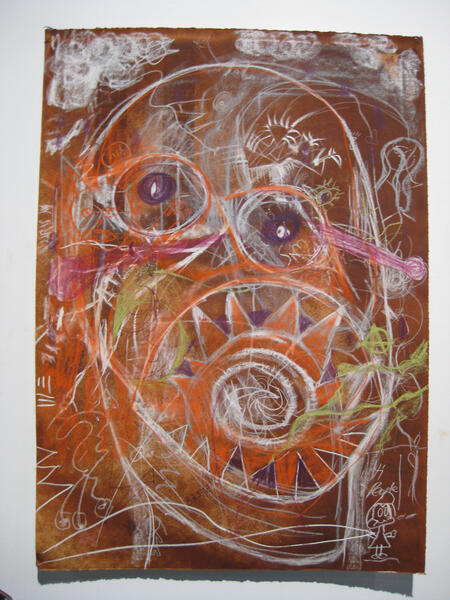 Récord, Recórd, recollection IIClosing image at the Chelsea Art Museum, 2007. The original portraits eventually fade, archiving the listeners through drawings such as this one. See Video.
Récord, Recórd, recollection IIClosing image at the Chelsea Art Museum, 2007. The original portraits eventually fade, archiving the listeners through drawings such as this one. See Video. -
 Récord, Recórd, recollection IIClosing image at the Chelsea Art Museum, 2007. The original portraits eventually fade, archiving the listeners through drawings such as this one. See Video.
Récord, Recórd, recollection IIClosing image at the Chelsea Art Museum, 2007. The original portraits eventually fade, archiving the listeners through drawings such as this one. See Video. -
 Récord, Recórd, recollection IIOpening, Chelsea Art Museum, 2007. Like the magnetic head of a tape recorder reading a cassette tape, viewers are invited to draw audio and hear citizens of Prague remembering their former Communist past. Sensors are hidden behind vandyke prints that eventually fade, archiving the listeners. See Video.
Récord, Recórd, recollection IIOpening, Chelsea Art Museum, 2007. Like the magnetic head of a tape recorder reading a cassette tape, viewers are invited to draw audio and hear citizens of Prague remembering their former Communist past. Sensors are hidden behind vandyke prints that eventually fade, archiving the listeners. See Video. -
 Récord, Recórd, recollection IIImage just prior to an opening and after. 6 39x60" panels (1 panel detail) Like the magnetic head of a tape recorder reading a cassette tape, viewers are invited to draw audio and hear citizens of Prague remembering their former Communist past. Sensors are hidden behind vandyke prints that eventually fade, archiving the listeners. See Video. Unfixed vandyke prints on rag paper; 40 7x7" force sensing resistors (sensors); speakers, analog to digital converters; apple laptop; Isadora and OSC software.
Récord, Recórd, recollection IIImage just prior to an opening and after. 6 39x60" panels (1 panel detail) Like the magnetic head of a tape recorder reading a cassette tape, viewers are invited to draw audio and hear citizens of Prague remembering their former Communist past. Sensors are hidden behind vandyke prints that eventually fade, archiving the listeners. See Video. Unfixed vandyke prints on rag paper; 40 7x7" force sensing resistors (sensors); speakers, analog to digital converters; apple laptop; Isadora and OSC software. -
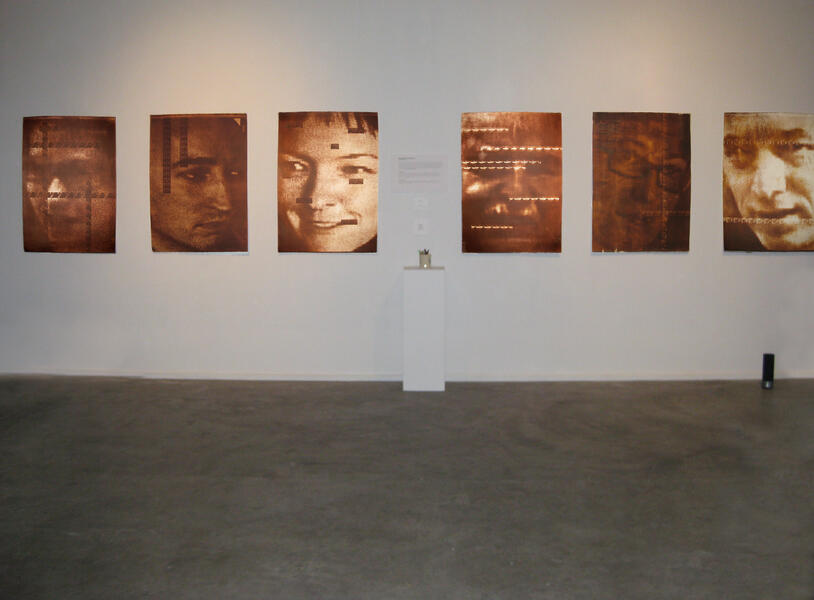 Récord, Recórd, recollection II6 39x60" panels (Installation) Like the magnetic head of a tape recorder reading a cassette tape, viewers are invited to draw audio and hear citizens of Prague remembering their former Communist past. Sensors are hidden behind vandyke prints that eventually fade, archiving the listeners. See Video. Unfixed vandyke prints on rag paper; 40 7x7" force sensing resistors (sensors); speakers, analog to digital converters; apple laptop; Isadora and OSC software.
Récord, Recórd, recollection II6 39x60" panels (Installation) Like the magnetic head of a tape recorder reading a cassette tape, viewers are invited to draw audio and hear citizens of Prague remembering their former Communist past. Sensors are hidden behind vandyke prints that eventually fade, archiving the listeners. See Video. Unfixed vandyke prints on rag paper; 40 7x7" force sensing resistors (sensors); speakers, analog to digital converters; apple laptop; Isadora and OSC software. -
Récord, Recórd, recollection II, 2003-2008Like the magnetic head of a tape recorder reading a cassette tape, viewers are invited to draw audio and hear citizens of Prague remembering their former Communist past. Sensors are hidden behind vandyke prints that eventually fade, archiving the listeners.
Cosmetic Series
Lipstick and cosmetics made from waterways that enter the Chesapeake Bay. Hand crafted by the artist.
-
 eLAND SeriesSouth Australian Site where "Flinders Ranges Body Paint" pigment was collected. Ancient mining site where white, yellow and red ochre have been mined for sacred painting including body paint for thousands of years. The minerals in these pigments are the same that Europeans used to create flesh tones. Photograph is 12x72" mounted. (see above)
eLAND SeriesSouth Australian Site where "Flinders Ranges Body Paint" pigment was collected. Ancient mining site where white, yellow and red ochre have been mined for sacred painting including body paint for thousands of years. The minerals in these pigments are the same that Europeans used to create flesh tones. Photograph is 12x72" mounted. (see above) -
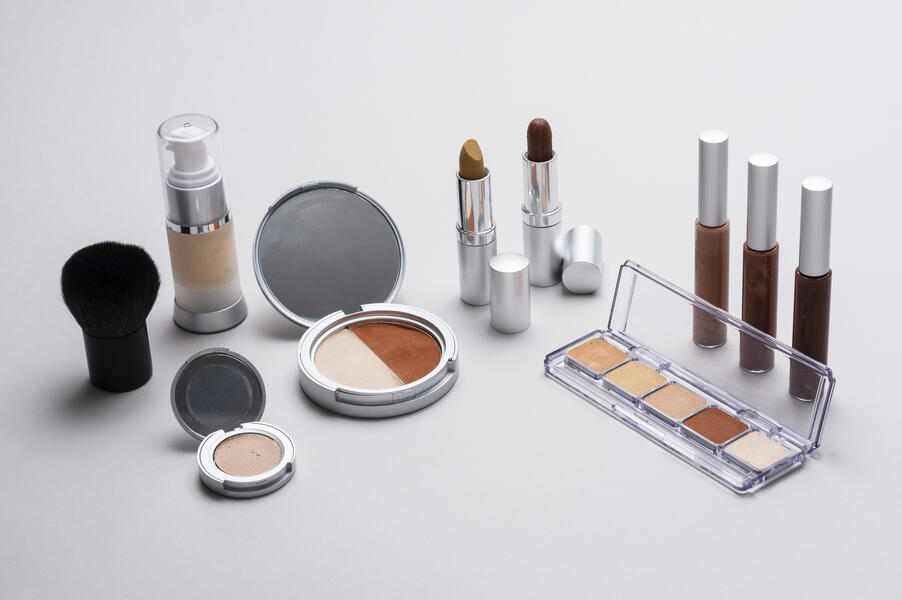 Flinders Ranges Body PaintHand crafted cosmetics created from discarded mines of the Dieri Songline from the Australian outback. Red and yellow ochre (iron ore), and titanium white are primary pigments for significant rituals across aboriginal peoples of the Australian continent and are the primary elements used to create 16th and 17th c. European flesh tones.
Flinders Ranges Body PaintHand crafted cosmetics created from discarded mines of the Dieri Songline from the Australian outback. Red and yellow ochre (iron ore), and titanium white are primary pigments for significant rituals across aboriginal peoples of the Australian continent and are the primary elements used to create 16th and 17th c. European flesh tones. -
 Ash, Rose and Mica (for post-911 New Yorkers)Hand cast lipstick and other cosmetics made from ash, rose and mica.
Ash, Rose and Mica (for post-911 New Yorkers)Hand cast lipstick and other cosmetics made from ash, rose and mica. -
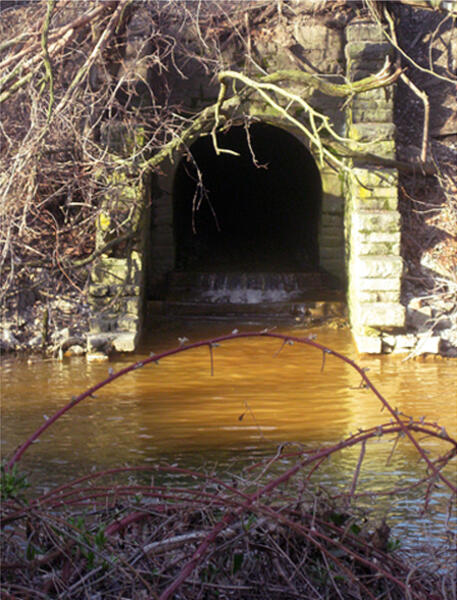 Chesapeake Bay Water LipstickBaltimore City waterway that enters the Chesapeake Bay where pigment for the lipstick was collected. Photograph by the artist 2010.
Chesapeake Bay Water LipstickBaltimore City waterway that enters the Chesapeake Bay where pigment for the lipstick was collected. Photograph by the artist 2010. -
 Chesapeake Bay Water LipstickHand cast lipstick and other cosmetics cast from waterways entering the Chesapeake Bay, Baltimore MD, collected by the artist. Boiled Bay water, mica, oil, wax and cosmetic cases, misc. materials.
Chesapeake Bay Water LipstickHand cast lipstick and other cosmetics cast from waterways entering the Chesapeake Bay, Baltimore MD, collected by the artist. Boiled Bay water, mica, oil, wax and cosmetic cases, misc. materials.
CHESAPEAKE BAY WATER WATERCOLORS
Iâ??ve wondered about how the romantic idea of nature is shifting and have been exploring ways to make surrounding water visible and audible. So for the Inner Harbor docks of the Baltimoreâ??s Transmodern Festival, I hand crafted watercolor pigments from water that feeds into the Chesapeake Bay. I created various brown, ochre and red-brown paintings, including postcard paintings that I displayed on a spinning postcard rack on the docks of the Harbor. The public was invited to make a painting to keep, or to donate it to my postcard rack. While people were painting and looking at the paintings, I collected 5 gallon buckets of water off the docks we were standing on, for both the painters, and to demonstrate the process of turning the surrounding waters into quality pigments. In addition to inviting the public to paint, I made kits and mailed them to artists such as Alison Knowles (Fluxus), Irene Chan, Mark Luce and others, who donated their paintings created from these pigments to the postcard rack.
-
CHESAPEAKE BAY WATER WATERCOLORSPostcard watercolors were displayed on a rack made from finely crafted pigments derived from Baltimore's waterways. During a performance, water was collected off the docks, boiled in a crock pot and attendees were given demonstrations on how to make their own pigment, or they could make a painting. Transmodern Festival, Baltimore Inner Harbor, 2010. (3:47min)
-
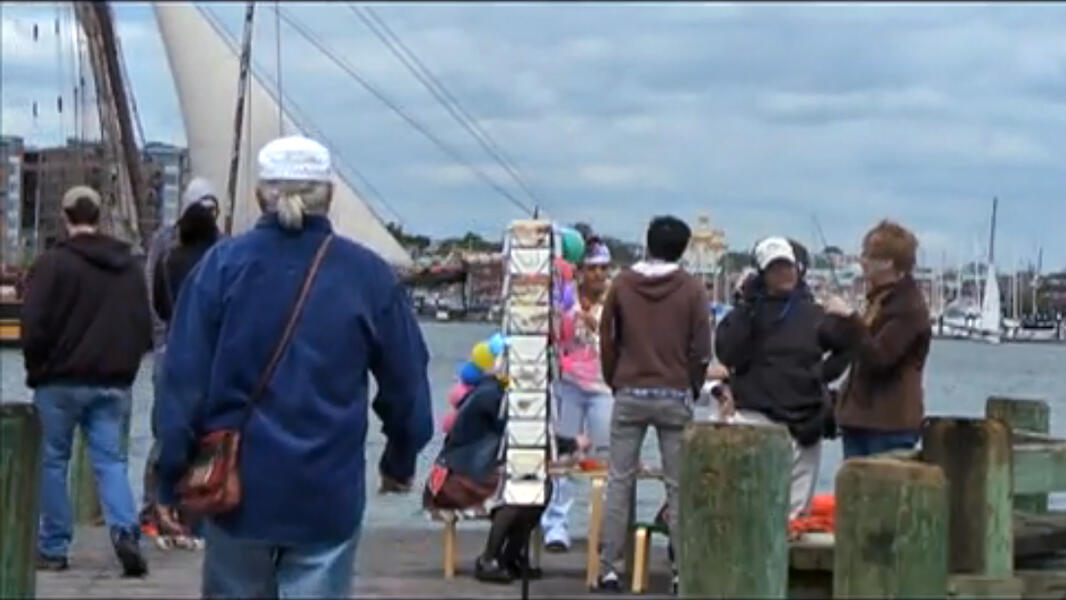 Chesapeake Bay Water WatercolorsPostcard watercolors were displayed on a rack made from finely crafted pigments derived from Baltimore's waterways. During a performance, water was collected off the docks, boiled in a crock pot and attendees were given demonstrations on how to make their own pigment, or they could make a painting. Video Still (3:47) Transmodern Festival, Baltimore Inner Harbor, 2010. (see video)
Chesapeake Bay Water WatercolorsPostcard watercolors were displayed on a rack made from finely crafted pigments derived from Baltimore's waterways. During a performance, water was collected off the docks, boiled in a crock pot and attendees were given demonstrations on how to make their own pigment, or they could make a painting. Video Still (3:47) Transmodern Festival, Baltimore Inner Harbor, 2010. (see video) -
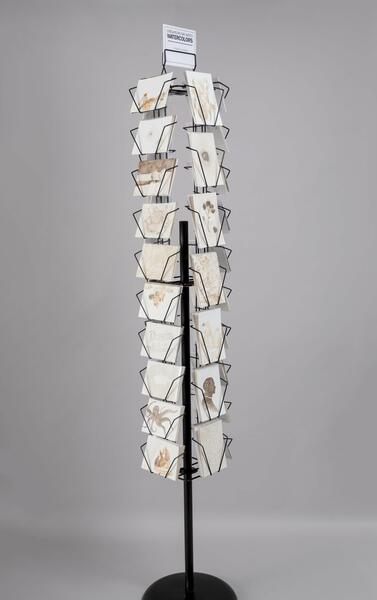 Chesapeake Bay Water Watercolors72x8x8" Over 100 postcards of watercolor paintings made from pigments derived from Baltimore's waterways. (see video of Inner Harbor festival performance)
Chesapeake Bay Water Watercolors72x8x8" Over 100 postcards of watercolor paintings made from pigments derived from Baltimore's waterways. (see video of Inner Harbor festival performance) -
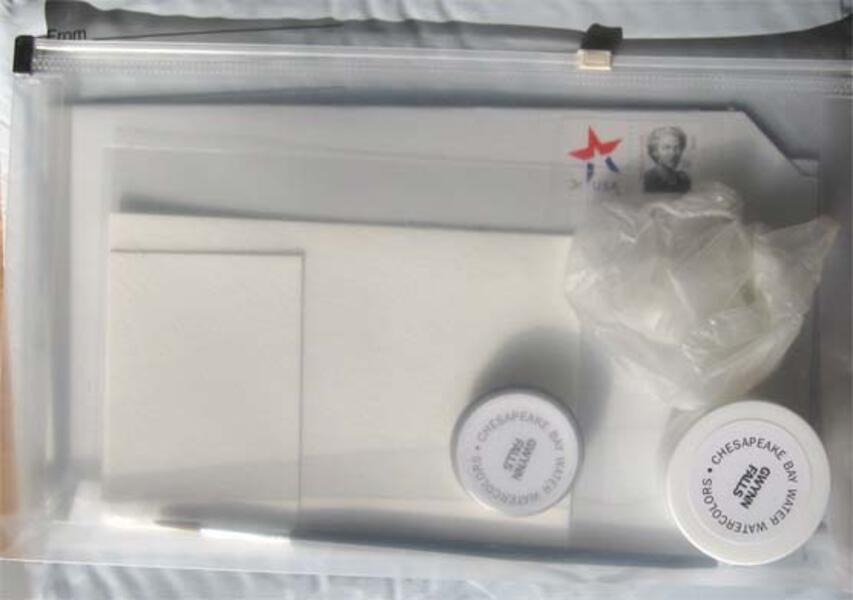 Chesapeake Bay Water WatercolorsPostcard watercolor kits were mailed to artists and illustrators world wide that included Chesapkeake Bay Water Watercolor pigments, brushes, paper, an SASE, etc. Paintings that were mailed back were displayed along with the artists paintings on a postcard rack. See video.
Chesapeake Bay Water WatercolorsPostcard watercolor kits were mailed to artists and illustrators world wide that included Chesapkeake Bay Water Watercolor pigments, brushes, paper, an SASE, etc. Paintings that were mailed back were displayed along with the artists paintings on a postcard rack. See video. -
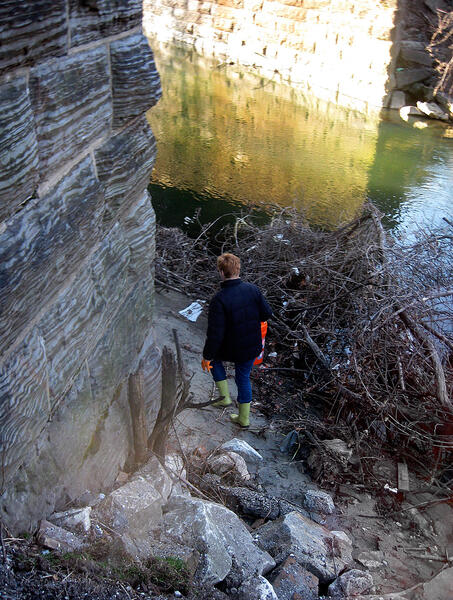 Chesapeake Bay Water WatercolorsThe artist collecting water to make pigment. Photograph by Tim Nohe. 2010.
Chesapeake Bay Water WatercolorsThe artist collecting water to make pigment. Photograph by Tim Nohe. 2010. -
 Chesapeake Bay Water Watercolors4x6" watercolor paintings
Chesapeake Bay Water Watercolors4x6" watercolor paintings
Marbleized Paper from the Gulf of Mexico
Along with most Americans in Spring 2010, I watched BPs Deep Water Horizon rig generate a massive oil spill devastating the Gulf of Mexico. On June 9, I went out on a small fishing boat in Bastian Bay, Louisiana with fisherman Captain Patrick, and collected both oil slicked water and oil that was dispersed with chemicals. When I returned to Baltimore, I used the collected oil towards traditional marbleizing techniques and made over 20 Marbleized papers and over 50 marbleized postcards. The over 30 images and 2000 word narrative that document the experience will be published by the Center for Art Design and Visual Culture (CADVC) in 2014.
-
 Marbleized Paper from the Gulf of MexicoExcerpt from book accepted for publication by the Center for Art Design and Visual Culture.
Marbleized Paper from the Gulf of MexicoExcerpt from book accepted for publication by the Center for Art Design and Visual Culture. -
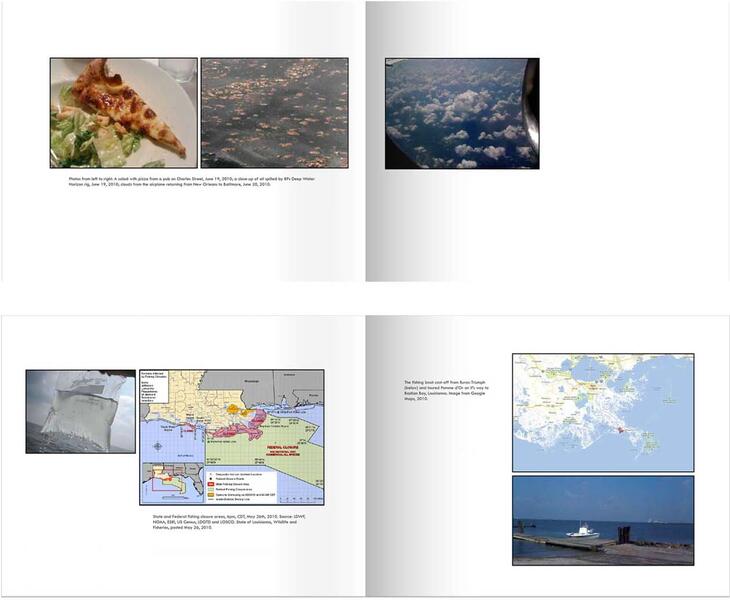 Marbleized Paper from the Gulf of MexicoExcerpt from book accepted for publication by the Center for Art Design and Visual Culture.
Marbleized Paper from the Gulf of MexicoExcerpt from book accepted for publication by the Center for Art Design and Visual Culture. -
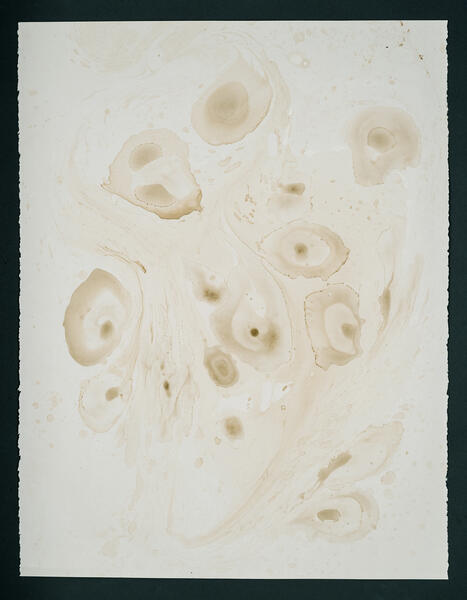 Marbleized Paper from the Gulf of Mexico22x30" oil on paper. Oil was collected by the artist from the Gulf of Mexico during the BP oil spill that devastated the region.
Marbleized Paper from the Gulf of Mexico22x30" oil on paper. Oil was collected by the artist from the Gulf of Mexico during the BP oil spill that devastated the region. -
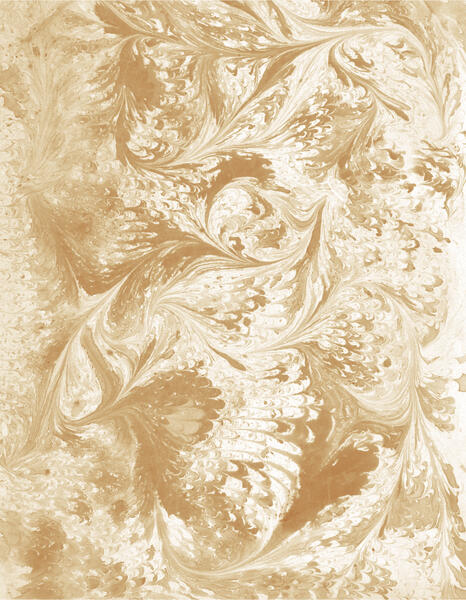 Marbleized Paper from the Gulf of Mexico22x30" oil on paper. Oil was collected by the artist from the Gulf of Mexico during the BP oil spill that devastated the region.
Marbleized Paper from the Gulf of Mexico22x30" oil on paper. Oil was collected by the artist from the Gulf of Mexico during the BP oil spill that devastated the region. -
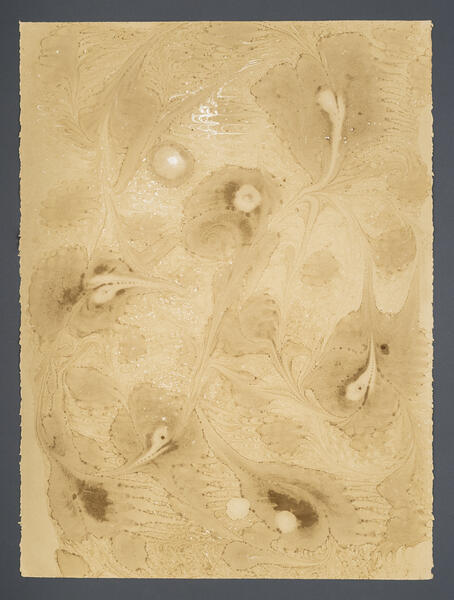 Marbleized Paper from the Gulf of Mexico22x30" oil on paper. Oil was collected by the artist from the Gulf of Mexico during the BP oil spill that devastated the region.
Marbleized Paper from the Gulf of Mexico22x30" oil on paper. Oil was collected by the artist from the Gulf of Mexico during the BP oil spill that devastated the region. -
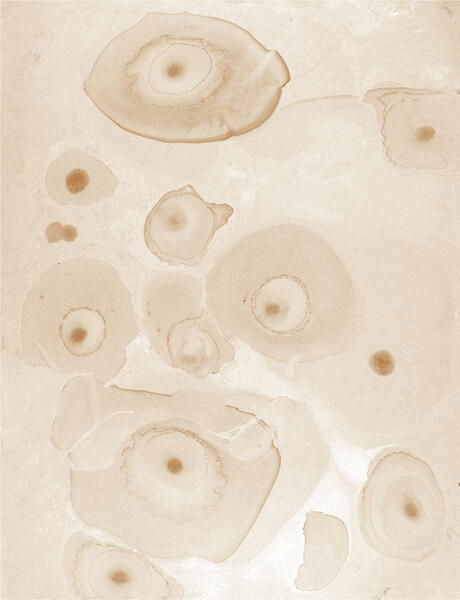 Marbleized Paper from the Gulf of Mexico22x30" oil on paper. Oil was collected by the artist from the Gulf of Mexico during the BP oil spill that devastated the region.
Marbleized Paper from the Gulf of Mexico22x30" oil on paper. Oil was collected by the artist from the Gulf of Mexico during the BP oil spill that devastated the region. -
 Marbleized Paper from the Gulf of Mexico22x30" oil on paper. Oil was collected by the artist from the Gulf of Mexico on day 50 of the BP oil spill that devastated the region.
Marbleized Paper from the Gulf of Mexico22x30" oil on paper. Oil was collected by the artist from the Gulf of Mexico on day 50 of the BP oil spill that devastated the region. -
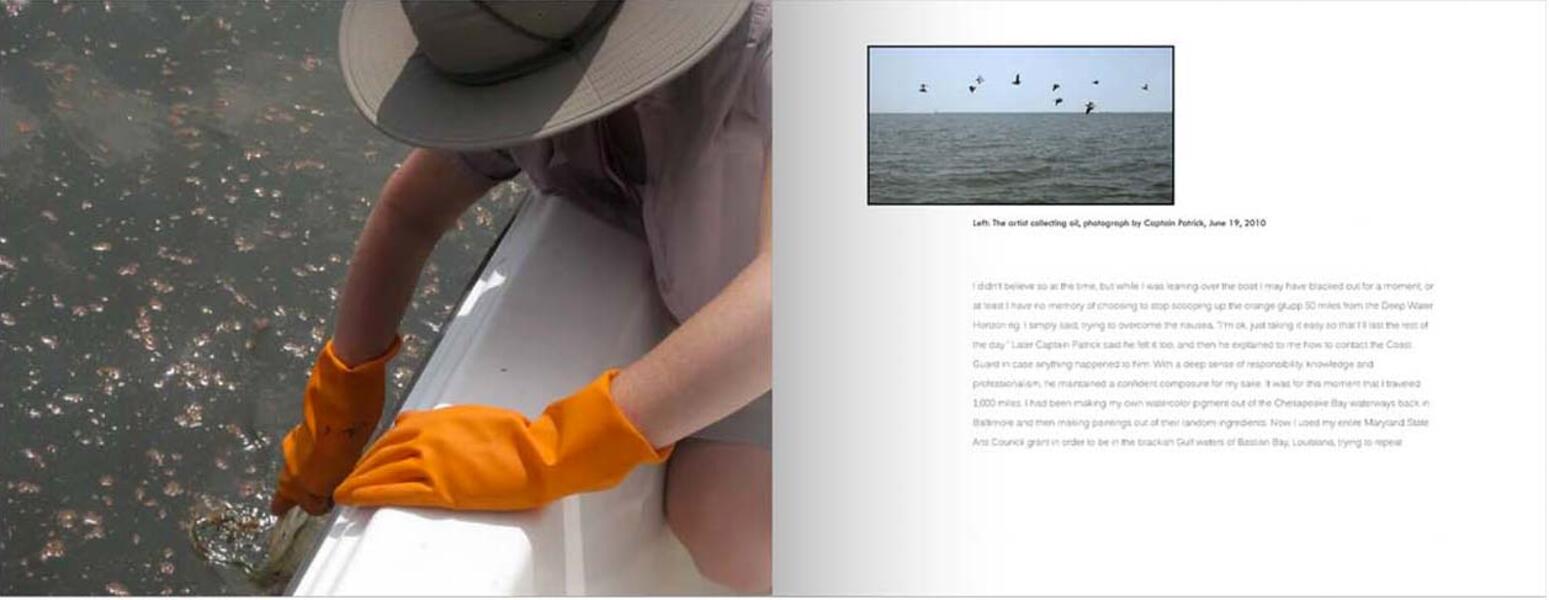 Marbleized Paper from the Gulf of MexicoExcerpt from book in progress published by the Center for Art Design and Visual Culture. Process photograph by Captain Patrick, Bastian Bay, LA, June 9, 2010.
Marbleized Paper from the Gulf of MexicoExcerpt from book in progress published by the Center for Art Design and Visual Culture. Process photograph by Captain Patrick, Bastian Bay, LA, June 9, 2010. -
 Marbleized Paper from the Gulf of Mexico22x30" oil on paper. (DETAIL) Oil was collected by the artist from the Gulf of Mexico during the BP oil spill that devastated the region.
Marbleized Paper from the Gulf of Mexico22x30" oil on paper. (DETAIL) Oil was collected by the artist from the Gulf of Mexico during the BP oil spill that devastated the region. -
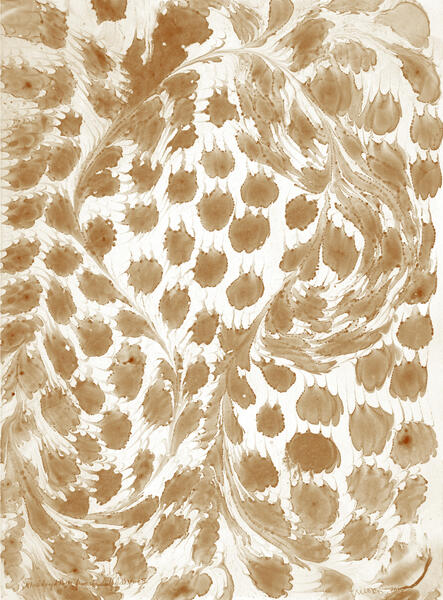 Marbleized Paper from the Gulf of Mexico22x30" oil on paper. Oil was collected by the artist from the Gulf of Mexico during the BP oil spill that devastated the region.
Marbleized Paper from the Gulf of Mexico22x30" oil on paper. Oil was collected by the artist from the Gulf of Mexico during the BP oil spill that devastated the region.
eLAND
The viewer approaches a series of red and yellow ochre prints, patterned in a grid, with clean edges and texture within the edges. They may soon realize that eLAND is a series of etchings embedded with a code. If the viewer selects the code a photograph of the landscape where the pigment they are viewing appears on their smartphone or tablet. Furthermore, the code is made up of pigment mined by artist from the discards of contemporary and ancient mining sites in the Australian outback. Additional information such as navigational GPS points and live stock quotations displaying an up-to-the-minute value of the pigment (South Australian iron ore), and other relevant mining and economic information.
I'm currently completing the final and largest dimensional etching that will be editioned for this series, making it a series of 4 editions including 1 tryptic and 1 quadratic.
I'm currently completing the final and largest dimensional etching that will be editioned for this series, making it a series of 4 editions including 1 tryptic and 1 quadratic.
-
 eLAND Series12 x 72" Photographic mounted, July 17, 2011 This rare document of an ancient pigment mining site is along the Songline of the Dieri Tribe. The artist collected red, yellow and white pigment from crevices nearby this sacred site. For more imagery: lisamoren.com/eLAND/
eLAND Series12 x 72" Photographic mounted, July 17, 2011 This rare document of an ancient pigment mining site is along the Songline of the Dieri Tribe. The artist collected red, yellow and white pigment from crevices nearby this sacred site. For more imagery: lisamoren.com/eLAND/ -
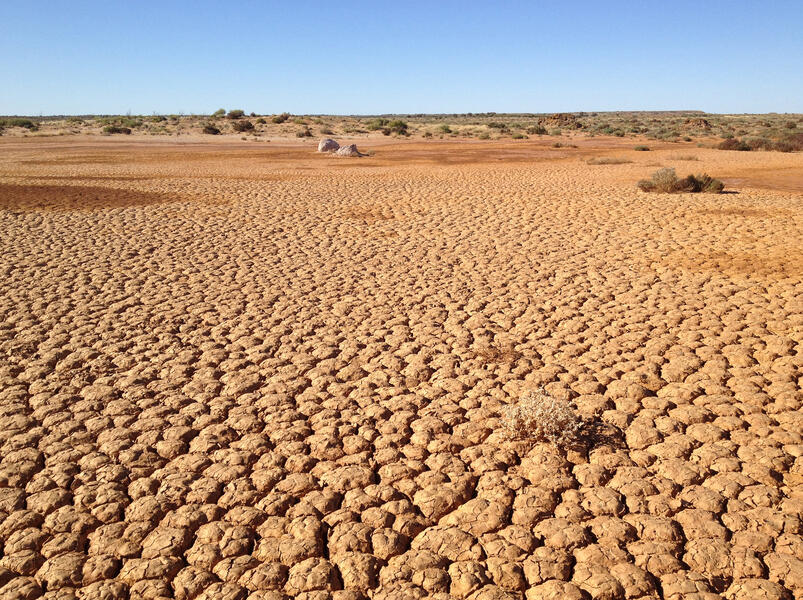 eLAND SeriesPhotograph July 17, 2011 This landscape image is off the trail of the Dieri Songline where pigment was collected for this project. For more imagery: lisamoren.com/eLAND/
eLAND SeriesPhotograph July 17, 2011 This landscape image is off the trail of the Dieri Songline where pigment was collected for this project. For more imagery: lisamoren.com/eLAND/ -
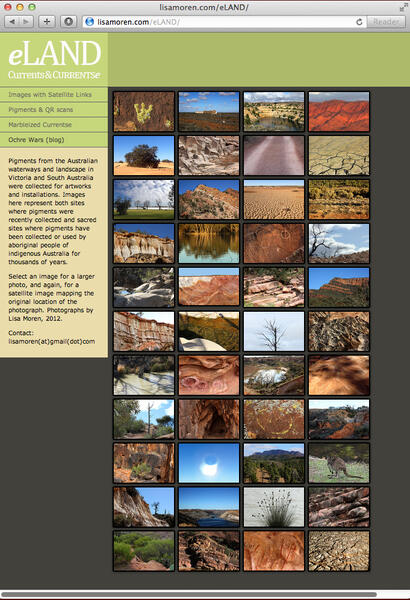 eLAND SeriesThis image is a thumbnail of the on-line archive holding the imagery for the eLAND Series. For images see: lisamoren.com/eLAND/
eLAND SeriesThis image is a thumbnail of the on-line archive holding the imagery for the eLAND Series. For images see: lisamoren.com/eLAND/ -
 eLAND SeriesPhotograph July 17, 2011 This image is of a working coal mining site in South Australia. Pigment was collected along the perimeter of this site, as the corporation discards the once highly valued red and yellow ochre (or kurra to the aborigines). For more photographic imagery see: lisamoren.com/eLAND/ For more economic, geographic and corporate information: lisamoren.com/eLAND/index6.html
eLAND SeriesPhotograph July 17, 2011 This image is of a working coal mining site in South Australia. Pigment was collected along the perimeter of this site, as the corporation discards the once highly valued red and yellow ochre (or kurra to the aborigines). For more photographic imagery see: lisamoren.com/eLAND/ For more economic, geographic and corporate information: lisamoren.com/eLAND/index6.html -
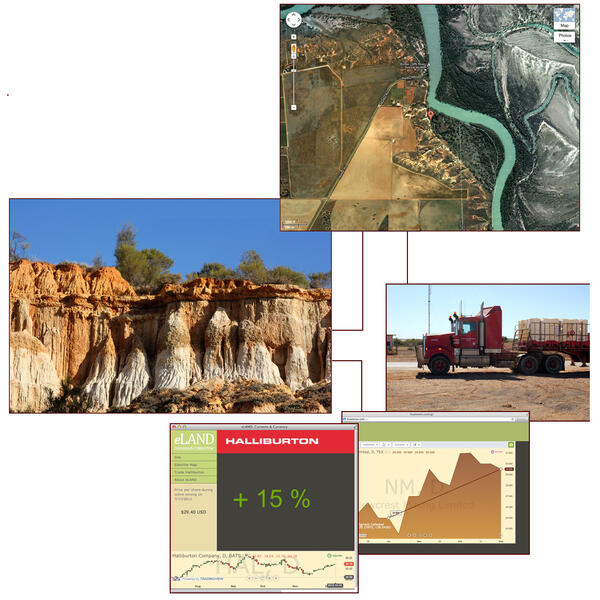 eLAND SeriesThis image shows the navigational path a viewer may encounter on a smartphone or tablet. It includes the image of the pigment they are viewing, it's GPS location and map, mining sites, a Halliburton truck at one of the sites and live stock quotes of the pigments minerals. To see the full website: lisamoren.com/eLAND/index6.html
eLAND SeriesThis image shows the navigational path a viewer may encounter on a smartphone or tablet. It includes the image of the pigment they are viewing, it's GPS location and map, mining sites, a Halliburton truck at one of the sites and live stock quotes of the pigments minerals. To see the full website: lisamoren.com/eLAND/index6.html -
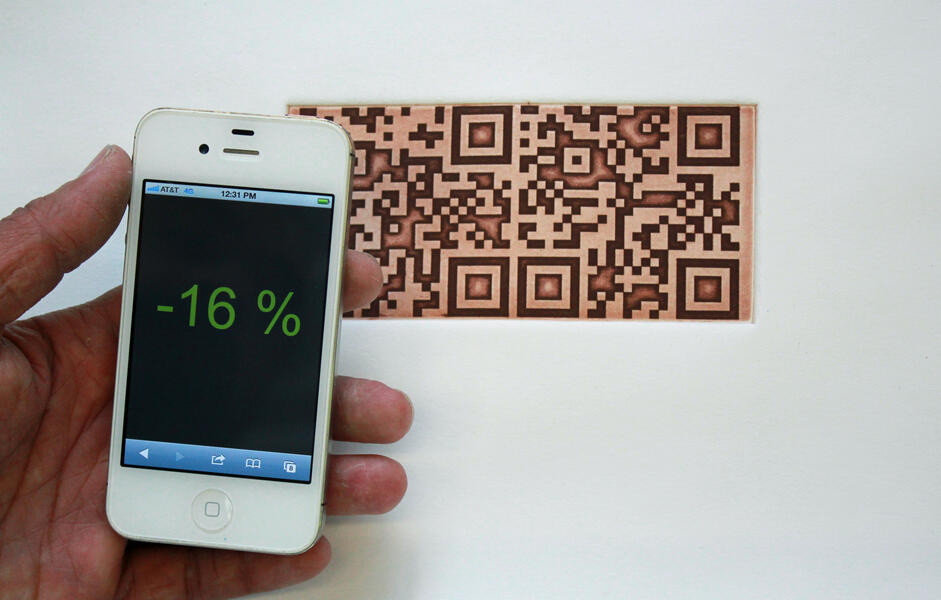 eLAND SeriesThis screen on a smartphone shows that since this pigment was mined in July 2012, the iron ore that it's made from has lost 16% of its value. For more stock, geographic and corporate info: lisamoren.com/eLAND/index6.html
eLAND SeriesThis screen on a smartphone shows that since this pigment was mined in July 2012, the iron ore that it's made from has lost 16% of its value. For more stock, geographic and corporate info: lisamoren.com/eLAND/index6.html -
 eLAND SeriesThis documents how the image appears on a smartphone. It's an image of the landscape where pigment was collected. The viewer can see how the rock colors match the pigment in the intaglio. For more images: lisamoren.com/eLAND/
eLAND SeriesThis documents how the image appears on a smartphone. It's an image of the landscape where pigment was collected. The viewer can see how the rock colors match the pigment in the intaglio. For more images: lisamoren.com/eLAND/ -
 eLAND SeriesPhotograph July 14, 2011 This is an image that will appear when the viewer selects the code on their smartphone or tablet. The image displays one of the sites where pigment was collected by the artist in South Australia. For more imagery: lisamoren.com/eLAND/
eLAND SeriesPhotograph July 14, 2011 This is an image that will appear when the viewer selects the code on their smartphone or tablet. The image displays one of the sites where pigment was collected by the artist in South Australia. For more imagery: lisamoren.com/eLAND/ -
 eLAND & eCurrency16x20" Intaglio triptych Each plate is the size of Australian 5, 10 and 20 dollar notes and printed with pigment mined by the artist from South Australia. The embedded codes allows the viewer to display current value of the pigment, how much the pigment has lost or gained in stock value since it was mined, etc. To see various links connected to this print: lisamoren.com/eLAND/index6.html
eLAND & eCurrency16x20" Intaglio triptych Each plate is the size of Australian 5, 10 and 20 dollar notes and printed with pigment mined by the artist from South Australia. The embedded codes allows the viewer to display current value of the pigment, how much the pigment has lost or gained in stock value since it was mined, etc. To see various links connected to this print: lisamoren.com/eLAND/index6.html -
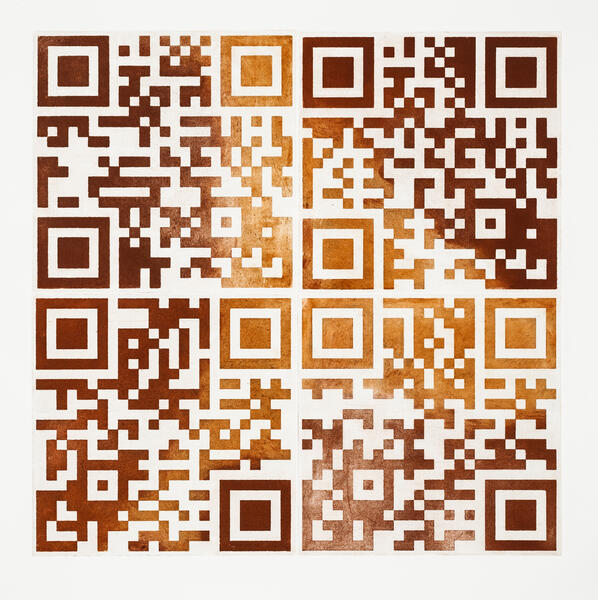 eLAND30x49" Intaglio Print (Quatratic) Hand made pigment mined by the artist in the Australian outback. 2013 One of 9 variations. Each of the 4 codes will allow the viewer to see a different aspect of the pigment that they are viewing with a smartphone or tablet. The viewer may see the landscape where the pigment was mined, current stock quote and value of the pigment, it's GPS location, how much the pigment has lost or gained value since it was mined, etc. To see various links connected to this print: lisamoren.com/eLAND/index6.html
eLAND30x49" Intaglio Print (Quatratic) Hand made pigment mined by the artist in the Australian outback. 2013 One of 9 variations. Each of the 4 codes will allow the viewer to see a different aspect of the pigment that they are viewing with a smartphone or tablet. The viewer may see the landscape where the pigment was mined, current stock quote and value of the pigment, it's GPS location, how much the pigment has lost or gained value since it was mined, etc. To see various links connected to this print: lisamoren.com/eLAND/index6.html
Songlines: Harmonograph Series
A series of intaglio prints where a 19th c. non-mechanical drawing machine (a harmonograph) draws on the etching plate. Pigments were collected by the artist in the Australian outback from discards of both ancient and contemporary mining sites. These sites followed the Dieri tribe's songline, a pilgrimage path, in South Australia where pigments were collected for a millennia.
The harmonograph is a 19th c. invention, a non-mechanical drawing machine that uses gravity and momentum to produce a continuous mathematical line. About a dozen 12x12" intaglio plates are ganged 6 plates per print, in order to produce 6 mono prints at 36x60".
This harmonograph was designed by Karl Simms and produced by Lukeworks, Inc., in collaboration with the artist. See the video for an example of the harmonograph drawing on an etching plate.
The harmonograph is a 19th c. invention, a non-mechanical drawing machine that uses gravity and momentum to produce a continuous mathematical line. About a dozen 12x12" intaglio plates are ganged 6 plates per print, in order to produce 6 mono prints at 36x60".
This harmonograph was designed by Karl Simms and produced by Lukeworks, Inc., in collaboration with the artist. See the video for an example of the harmonograph drawing on an etching plate.
-
 Songlines: A Harmonograph Series (process image)A harmonograph is a 19th c. non-mechanical drawing machine that uses pendulums, gravity and momentum. It was originally invented in Scotland in order to make visible a mathematical curve theorized by a French mathematician. This hand-made harmonograph is a 3-pendulum design by Karl Simms that I modified with Lukeworks, Inc. I use it primarily to draw on etching plates. This gravity-drawing machine is in response to the Dieri tribe's songline (a pilgrimage path) in the Australian outback where the tribe collected and traded the most valuable pigments used across the continent. It was like currency. The pigments used in this intaglio series I collected from the discards of ancient and contemporary mining sites along the Dieri's songline. (See Video for the harmonograph drawing on an etching plate)
Songlines: A Harmonograph Series (process image)A harmonograph is a 19th c. non-mechanical drawing machine that uses pendulums, gravity and momentum. It was originally invented in Scotland in order to make visible a mathematical curve theorized by a French mathematician. This hand-made harmonograph is a 3-pendulum design by Karl Simms that I modified with Lukeworks, Inc. I use it primarily to draw on etching plates. This gravity-drawing machine is in response to the Dieri tribe's songline (a pilgrimage path) in the Australian outback where the tribe collected and traded the most valuable pigments used across the continent. It was like currency. The pigments used in this intaglio series I collected from the discards of ancient and contemporary mining sites along the Dieri's songline. (See Video for the harmonograph drawing on an etching plate) -
Songlines: A Harmonograph Series (process video)This video shows the harmonograph drawing on an etching plate. A harmonograph is a 19th c. non-mechanical drawing machine that uses pendulums, gravity and momentum. It was originally invented in Scotland in order to make visible a mathematical curve theorized by a French mathematician. This video shows my hand-made harmonograph which is a 3-pendulum design by Karl Simms and modified by myself with Lukeworks, Inc. in Baltimore. I use the device primarily to draw on etching plates. This gravity-drawing machine is in response to the Dieri tribe's songline (a pilgrimage path) in the Australian outback where the tribe collected and traded the most valuable pigments used across the continent. It was like currency. The pigments used in this intaglio series I collected from the discards of ancient and contemporary mining sites along the Dieri's songline.
-
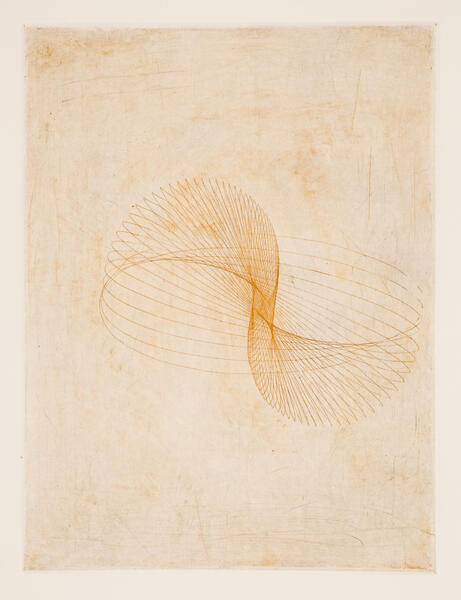 Songlines: A Harmonograph Series11x14" Intaglio An edition where a harmonograph draws on an etching plate. Pigments were collected by the artist in the Australian outback from discards of both ancient and contemporary mining sites. These sites followed the Dieri tribe's songline, a pilgrimage path, in South Australia where pigments were collected for a millennia. (See Video for harmonograph process)
Songlines: A Harmonograph Series11x14" Intaglio An edition where a harmonograph draws on an etching plate. Pigments were collected by the artist in the Australian outback from discards of both ancient and contemporary mining sites. These sites followed the Dieri tribe's songline, a pilgrimage path, in South Australia where pigments were collected for a millennia. (See Video for harmonograph process) -
 Songlines: A Harmonograph Series (detail)36x60" Intaglio with chine collé This details one of the intaglio plates drawn by the harmonograph with a chine collé layer. Songlines is series of intaglio's where a hand-made harmonograph draws on a series of etching plates and paper that is collaged in the prints. Pigments were collected by the artist in the Australian outback from discards of both ancient and contemporary mining sites. These sites followed the Dieri tribe's songline, a pilgrimage path, in South Australia where pigments were collected for a millennia. (See Video for harmonograph process)
Songlines: A Harmonograph Series (detail)36x60" Intaglio with chine collé This details one of the intaglio plates drawn by the harmonograph with a chine collé layer. Songlines is series of intaglio's where a hand-made harmonograph draws on a series of etching plates and paper that is collaged in the prints. Pigments were collected by the artist in the Australian outback from discards of both ancient and contemporary mining sites. These sites followed the Dieri tribe's songline, a pilgrimage path, in South Australia where pigments were collected for a millennia. (See Video for harmonograph process) -
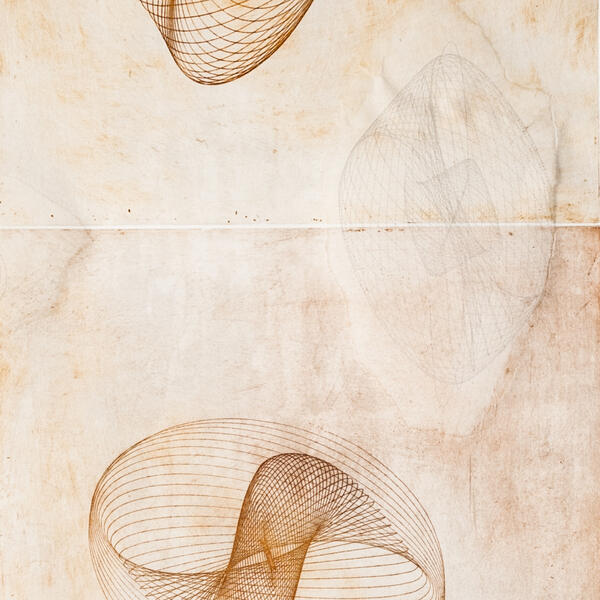 Songlines: A Harmonograph Series (detail)36x60" Intaglio with chine collé This details an example of where the graphite on the harmonograph drew onto drafting paper and then was collaged in with the print (or chine collé). Songlines is series of intaglio's where a harmonograph draws on a series of etching plates, and paper that is collaged in during the printing process. Pigments were collected by the artist in the Australian outback from discards of both ancient and contemporary mining sites. These sites followed the Dieri tribe's songline, a pilgrimage path, in South Australia where pigments were collected for a millennia. (See Video for harmonograph process)
Songlines: A Harmonograph Series (detail)36x60" Intaglio with chine collé This details an example of where the graphite on the harmonograph drew onto drafting paper and then was collaged in with the print (or chine collé). Songlines is series of intaglio's where a harmonograph draws on a series of etching plates, and paper that is collaged in during the printing process. Pigments were collected by the artist in the Australian outback from discards of both ancient and contemporary mining sites. These sites followed the Dieri tribe's songline, a pilgrimage path, in South Australia where pigments were collected for a millennia. (See Video for harmonograph process) -
 Songlines: A Harmonograph Series36x60" Intaglio print with chine collé Songlines is a hexaptych (6 panel) series of intaglio prints and artist proof's. A hand-made harmonograph draws on a series of metal plates that are later etched and printed. Pigments were collected by the artist in the Australian outback from discards of both ancient and contemporary mining sites. These sites followed the Dieri tribe's songline, a pilgrimage path, in South Australia where pigments were collected for a millennia. (See Video for harmonograph process)
Songlines: A Harmonograph Series36x60" Intaglio print with chine collé Songlines is a hexaptych (6 panel) series of intaglio prints and artist proof's. A hand-made harmonograph draws on a series of metal plates that are later etched and printed. Pigments were collected by the artist in the Australian outback from discards of both ancient and contemporary mining sites. These sites followed the Dieri tribe's songline, a pilgrimage path, in South Australia where pigments were collected for a millennia. (See Video for harmonograph process)





